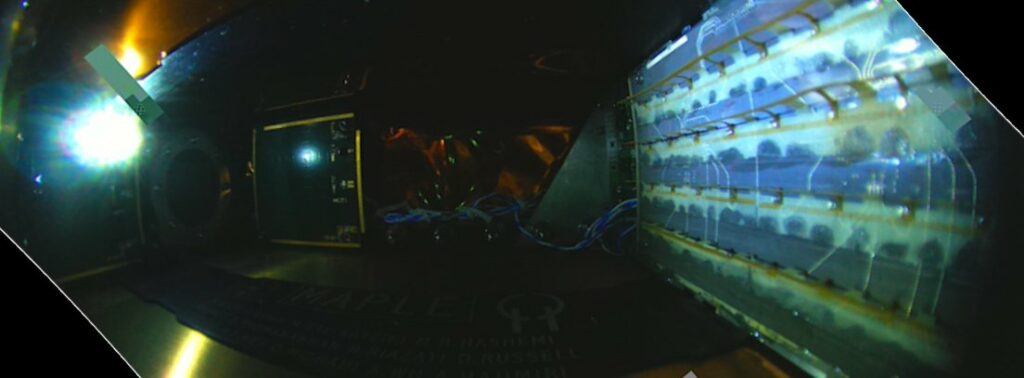Inspenet, June 5, 2023
Researchers at the California Institute of Technology (Caltech) wirelessly sent solar energy captured in space back to Earth, using a space solar power prototype that was launched into orbit in January.
The Space Solar Power Demonstrator (SSPD-1), which has demonstrated its ability to wirelessly transmit power in space and transmit detectable power to Earth, consists of a main module dubbed ‘MAPLE’.
The scientists say it is the first time this milestone has been achieved. “As far as we know, no one has ever demonstrated wireless power transfer in space, even with expensive rigid structures. We are doing it with flexible lightweight structures and with our own integrated circuits. This is the first time,” says Ali Hajimiri, who led the investigation.
“Through the experiments we have conducted so far, we received confirmation that MAPLE can successfully transmit energy to receivers in space,” Hajimiri commented. “We were also able to program the array to direct its energy toward Earth, which we detected here at Caltech. Of course, we tested it on Earth, but now we know it can survive space travel and operate there.”
MAPLE, short for Microwave Array for Low Orbit Energy Transfer Experiment, consists of an array of microwave power transmitters. The transmitters are lightweight to minimize the amount of fuel needed to send them into space. They are flexible so that they can be packed up and transported in a rocket. “Flexible power transmission arrangements are essential for the design […] of a constellation of sail-like solar panels that unfold once they reach orbit,” explains Sergio Pellegrino, co-director of the project.

Space solar energy: A project for the benefit of all humanity
Space solar power provides a way to harness the virtually unlimited supply of solar power in outer space, where power is constantly available without being subject to the cycles of day and night, seasons, and clouds. This technology would potentially produce eight times more energy than solar panels installed anywhere on the Earth’s surface.
“In the same way that the Internet democratized access to information, we hope that wireless power transfer will democratize access to power,” says Hajimiri. “No power transmission infrastructure will be needed on the ground to receive this power. That means we can send power to remote regions and areas devastated by war or natural disaster,” the expert insisted.
“The hard work and dedication of the brilliant scientists at Caltech have advanced our dream of providing the world with abundant, reliable and affordable energy for the benefit of all humanity,” says entrepreneur philanthropist Donald Bren, who created a trust to finance the research project.
“Donald Bren has presented a formidable technical challenge that promises a remarkable reward for humanity: a world powered by uninterrupted renewable energy,” said Thomas F. Rosenbaum, president of Caltech.
There is still a long experimental way to go
“Demonstrating wireless power transfer in space using lightweight structures is an important step toward space solar power and wide access to it globally,” says Harry Atwater, one of the project’s principal investigators. “Solar panels are already used in space to power the International Space Station, for example, but to launch and deploy panels large enough to provide power to Earth, SSPP has to design and create energy power transfer systems. solar panels that are ultra-light, cheap and flexible,” he stressed.
The SSPD also incorporates a device called ‘DOLCE’ (Deployable Ultralight Composite Experiment in Orbit). This structure, just over 3 square meters, is a demonstration of the architecture, packaging scheme and deployment mechanisms of the modular spacecraft.
The ALBA module is a collection of 32 different types of photovoltaic cells to allow an evaluation of the cell types that are most effective in the harsh environment of space.
Source : Actualidad RT in Spanish
Photos : NASA/JPL-Caltech/SSPP
Don’t miss the Inspenet News at: https://inspenet.com/en/inspenet-tv/


